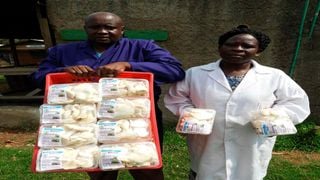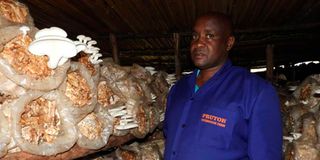
Paul Ruto and his wife Nancy at their mushroom farm in Tumbelyon village, Kaplong location, Bomet County.
Seeds of Gold
Premium
We pick our money from mushrooms
What you need to know:
- With a capital of Sh50,000, Paul Ruto built shelves to hold 140 bags, bought mushroom seeds and propagated them in August, 2017.
- He runs the farm with his wife, Nancy, a primary school teacher, and has employed five workers, including two salesmen.
Paul Ruto was a distraught man some five years ago when his passion fruit and dairy enterprises collapsed.
He had pumped Sh300,000 loan from a commercial bank into the business and delegated a worker to take care of the crops and animals.
“The businesses collapsed due to poor management. I trusted the farmhand but I came to realise he did not know much on managing the cows and fruits leading to diseases.”
Not one to give up, Ruto did research on what crop he can grow well as a telephone farmer. He landed on mushrooms.
“What interested me in the crop is that it could be commercialised under a very small space. I visited farmers in Kakamega, Nyanza and North Rift regions for lessons,” says the farmer, who is based in Kaplong, Bomet. He then paid Sh3,000 for mushroom growing training on a farm in Kakamega County.
“I returned home and converted the dairy unit into a mushroom house,” says Ruto.
With a capital of Sh50,000, he built shelves to hold 140 bags, bought mushroom seeds (spawns) and propagated them in August, 2017. His first harvest came after about a month, with the farmer selling the produce in Sotik, Kaplong, Litein and Bomet towns earning some Sh41,000.

Paul Ruto at his mushroom farm in Tumbelyon village, Kaplong location, Bomet County.
He planted 400 bags in the second season, subsequently raising the number to 1,000 bags after expanding the structures, says Ruto, who holds an MBA in social entrepreneurship from Tangaza College, and a wood science degree from Moi University.
He runs the farm with his wife, Nancy, a primary school teacher, and has employed five workers, including two salesmen, who distribute the produce in Kisii, Keroka, Bomet, Nyamira, Chebilat, Sotik and Litein towns.
“I now make up to four times more my initial profit. It is a gamble that eventually paid off,” says Ruto, who farms the button variety.
Mushrooms are rich in vitamins, protein, minerals and antioxidants (including selenium, vitamin C and choline). They can be eaten raw or cooked.
Ruto, a member of the Mushrooms Growers Association of Kenya, sources spawns from Kenya Industrial Research and Development Institute or Museums of Kenya. Before that, he makes substrate (growing media) from saw dust, wheat bran and lime.
He sprinkles water on it to raise moisture content after putting them into industrial bags approved by the National Environmental Management Authority (Nema), which he sources from dealers in Nairobi and Thika.
Grown organically
He later places the bags in the mushroom dark room and plants. Harvesting happens every three days for two-and-a-half months.
“We package the mushroom in 250g containers branded Prutoh Mushrooms, which we sell at between Sh100 and Sh150 to supermarkets, hotels and individuals.”
Ruto says he is working on a business plan to cover the next 30 years of the enterprise with plans to extend operations nationally and across East Africa.
Joseph Langat, an agricultural officer at the Bomet county government, says mushrooms are grown organically thus one should strive harder to curb pests and diseases.
He says diseases such as green mould, dactylium and verticillium spots are prevented through proper sanitation.
“The entry into the mushroom house should have a footbath so that workers and visitors disinfect their shoes.”
He says besides button and oyster mushroom varieties, which are popular in the market, farmers can also grow morel, cremini, portabellu, shiitake, chanterelle, enoki and porcini.





